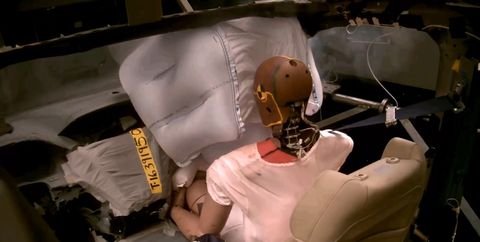Honda will introduce new front passenger airbag design in 2020

The new design rethinks the conventional single inflatable compartment airbag design in favor of a unique three-chamber design — a center chamber and two outward-projecting side chambers, connected by a mesh “sail panel” — that engineers liken to a catcher’s mitt. It also inverts the V-shape of a conventional airbag and brings the restraining surface closer to the occupant when deployed.
It’s designed to cushion and limit the rotational velocity of the passenger’s head in a collision. Analysis of brain injury criterion, or BrIC, suggests the new airbag offers 75% reduction in the rotational velocity of the head in a crash. It works with the added slack in modern seatbelts to distribute the force of impact between the seatbelt and airbag and limit injury to the occupant’s chest.
Development was based on research into the effects of airbag-protected collisions on brain tissue as measured by MRI scans. Honda developed the new technology, which is co-patented with the auto supplier Autoliv, and validated it at its sprawling R&D facility in central Ohio, which features a full crash-test dummy lab, a pitching sled to study and validate crashworthiness and passive safety systems, and a crash barrier lab to conduct crash tests on full production vehicles.
“We are adding this feature because it’s safer and we know it’s beneficial to our customers,” said Eric Heitkamp, crashworthiness technical leader for Honda R&D Americas.
Honda wouldn’t say which model or models would get the new airbag first, or exactly when. The new airbag will be made available to other automakers through Autoliv, Honda officials said.
Honda says it was the first automaker to introduce an upward-deploying front passenger airbag in 1990 in the Acura Legend.
Related News


